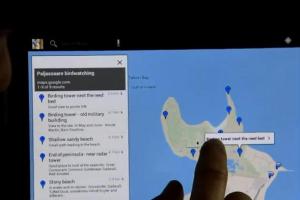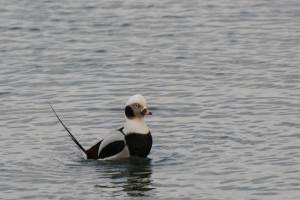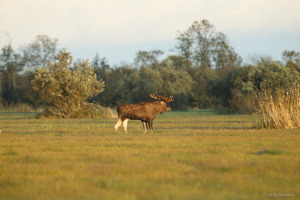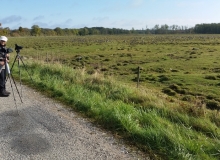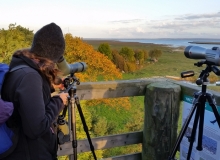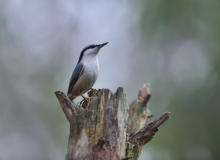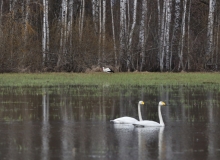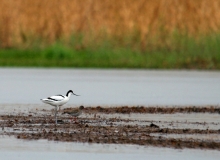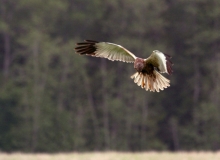The biggest advantage of a self-guided tour is flexibility. Therefore the easiest way to set it up is by writing us when and for how long would you like to stay. Which species and habitats would you like to see? Through the given information, we will organize the fitting tour specially made for you. You can concentrate only on birding, or mix it with mammal observation, or even mix the two together with searching for rare orchids in Estonia’s wooded meadows. In case you want to get more in touch with the local history and culture, we can also add the best or most fitting sightseeing locations. If you want a more active tour, we can add walking trails to your tour and for photographers arrange photo hides.
WHEN
March and the end of April are the best times for seeing wintering arctic waterfowl. During the mentioned period, there’s a great chance to observe Steller’s Eider and thousands of Long-tailed Ducks, feeding on the west coast of Saaremaa island. In the meantime, the spring migration is slowly starting and every day brings new species. Usually, the early arrivals include species like Cranes, Skylarks, and Northern Lapwings. Commonly it is also the best time for seeing arctic passerine birds like the Snow Bunting, Arctic Redpoll or even Lapland Longspur.
On warmer days the woodpeckers get more active and then it’s possible to hear the drumming of species such as the White-backed Woodpecker, Three-toed Woodpecker, Black Woodpecker, Lesser-spotted Woodpecker and Grey-headed Woodpecker. In the evening, there’s a chance to see or hear the Pygmy Owl, Ural Owl or Tengmalm’s Owl. Black Grouses are already lekking and Western Capercaillies and Hazel Grouses are just starting to. March and April are also good months for Elk spotting.
In April the migration is getting stronger every day and then there’s the chance to see new arctic species such as the Greater Scaup, Common- and Velvet Scoter, different Loons, Geese, and Swans. In the meantime, new and new nesting birds are arriving. April is also the best time for spotting woodpeckers, owls, and Galliformes.
The migration lasts until the middle of May and that is also the time when it is possible to see the greatest number of different species. By that time, late arrivals such as the Common Rosefinch, Blyth’s Reed Warbler, Greenish Warbler have just arrived. Earlier nesters are still active and the waterfowl migration has not ended yet.
May is also the best time for seeing local mammals – the Elks feed on fresh grass and leaves and are easy to spot. Bears start visiting the bear watching hide and also sightings of foxes and raccoon dogs will become frequent. Estonia has also a good number of Wolves, Lynx, Jackals, Wild Bore, Otters and other mammals and May is a really good month for accidental observations. In this month, Flying Squirrel tours can also be planned, as there is sufficient light even in the woods. End of May is also a good time for looking for the first blossoming orchids, such as the majestic Lady’s Slipper. The best time to see as many orchids as possible is at the end of June and in the beginning of July.
While the summer is quite calm in terms of nature observations, it again gets more interesting from the middle of September when autumn bird migration starts off. During the autumn migration, there are not so many different species, but the masses are greater, as the migration takes place during a shorter period. From the middle of September onwards, thousands of Cranes will start gathering on the fields, later accompanied by various species of geese. When the nights get colder, Hazel Grouse and Western Capercaille get more active again and for the Black Grouse, it signifies the beginning of the autumn lek. Besides the Galliformes, autumn is also an active period for owls and woodpeckers. In terms of mammals, Brown Bears and Raccoon Dogs will be actively looking for food as they need to fatten up for the winter and the chances to spot them are much greater than during summer. Colder nights and shorter days trigger the rutting period of the Elk, which normally lasts from the end of August until the middle of October. The end of the elk rut signifies also the end of our autumn season.
Feel free to ask any questions or book your holiday- please contact us: info@natourest.ee or by phone:
+372 5622 5943
Lukas used the self-guided map in August 2019:
Julia and Daniel made at first a group tour organized by Natourest and Birdingtours, and subsequently a Tailor-Made Self-Guided Tour in September 2018.
Karl had already summarized our group trip together on the last evening. There is hardly anything to add – it was just great!
Our subsequent private tour was beautiful as well.
We actually visited all the points that you both recommended us and had there again great wildlife observations.
After Tallinn, we made a stop in Marimetsa peat bog, on the way to Saaremaa, and made a hike. A really beautiful and varied hike, which included a hazel grouse sighting and a swim in a bog pool.
On Saaremaa, we were by the crooked lighthouse, at the northern tip and then drove also to the southwestern tip(with many stops). On Saaremaa we observed, among others: „a city deer“, a doe with a fawn, Long-tailed Duck, a great number o Barnacle Geese with a few Bar-headed Geese, Loons and an Elk.
After that, we were at Pikla Birdhouse – even though the weather was so-so, the place itself was really nice. From there we drove to Soomaa and on the second day to Nigula Bog, with a stop at Rannametsa Bog.It was raining a bit in Nigula Bog, which did not bother us much, as we found a shelter on about half of the way. In Soomaa we did practically all the tours from the tablet. Among other, we had observations of black grouse, a crazy Nutcracker, a Golden Eagle (passing by, only 20m away!).
At Pikla Birdhouse, we saw Bearded tits, White-tailed Eagle, and on the last morning in the bog, a sunrise with fog and no wind, absolute class!
On our way to the bear hide (again with stop and hike in Soomaa NP) a Capercaillie stood directly on the roadside. We almost did not believe our eyes! The bear hide was great again! A total of 2 or 3 different bears came again really early (about 17:00 PM) in good light conditions, and even from the west side of the hide, it came out when the light conditions were still good. One of the bears was extremely relaxed and laid down several times next to the hidden bait and ate in peace. The night was bitterly cold – in the morning, there was ice on the car (we probably caught the flu from there).
In the morning, on our way back from the hide to the car, we saw a Hazel Grouse (flying from the edge of the road) and Capercaillie (directly on the way in about 50m distance from the barrier chain). Afterwards, we also saw Black Grouse from the car – thus 3 grouse species within 2 hours – just crazy!
At the end in Palmse, we both had caught a cold. Therefore, we had to take it a little easier there. Therefore, we could not stay for the third planned night in the bear hide. Thanks again to Peep for the uncomplicated cancellation of the bear hide.
In the north, we were again at the points where we were already during the group tour. It was partly very windy and stormy. At the primaeval forest trail, an old spruce fell down about 10m away from us. (Lucky!). Therefore, we finished the trail a bit faster than usual (in addition, there were 2 more really loud crash-noises nearby). We hiked to Majakivi on the last day before the departure – also a very nice trail!
During the last part of our trip, we had sightings of Black Woodpecker, Oystercatcher (Purekarri – the middle finger of Lahemaa) and flocks of Brent Geese, Eurasia Wigeons and Velvet Scoters. So, that was our short summary.
Thanks again to you for the great impressions on the group trip and the great compilation of the private tour. Everything went very well and we really enjoyed it. We will come back and recommend both of them to other!
“Thank you, thank you, thank you … the trip was the coolest!”
many Greetings
Julia and Daniel
Ken and Anne made a Tailor-Made Self-Guided tour in May 2018
The car was absolutely fine for us, the right size, nice to drive and economical.
A couple of suggestions, maybe for the representative from the hire company. It might be an idea to tell customers, at least English ones, that it is compulsory to drive with lights on at all times. Also, perhaps explain that the only way to put fuel in the tank is to pre-pay a set amount using a machine next to the pumps. In the UK we put in as much as we want then go into the shop to pay. But it was fun learning what to do! And of course, there is so little traffic that driving is easy and a pleasure.
All the accommodation was very good, and everyone was kind and helpful. Breakfasts were all good with plenty of choices – we enjoyed Estonian porridge! We had an evening meal at Klaara Manni and all our evening meals at Loona Manor and they were all good. We found good restaurants which we enjoyed in Haapsalu and Tallinn.
It was really good to have the tablet with all the information we could possibly need, along with the ability to use Google maps to get us to any location.
Sightings: Soomaa was a disappointment, but that was probably our fault. The weather there was so hot, around 30/32c with no breeze and a lot of times no shelter, and the mosquitoes were troublesome, and so we probably were not out and about and concentrating as much as we should. We loved Haapsalu, Poosaspea and the National Parks north, and also Matsalu, although we only explored the Northern part around Matsalu lath. Also, we enjoyed Vilsandi on Saaremaa, especially the trail at Harilaid. (The information centre there was excellent.) We also hired bicycles and looked for orchids, but I think we were a little early. We found Military, Green-winged and Early purple. About wildflowers generally, it was lovely to see them in such profusion. Cowslips were amazing and Lily of the Valley ( Convalaria), but we were a bit too early to see them in flower. Pasque flowers were also fantastic.
For us, who see geese and wildfowl in cold winter weather, it was great seeing huge flocks of geese, ducks, grebes cranes, etc in the sun. We enjoyed red-breasted flycatcher, scarlet rosefinch and, surprisingly, rose-coloured starling. I think there has been a westward movement this year. Below is a copy of the list of our sightings reported on Birdtrack.
It’s hard to say if the tour could be changed. We normally rent a house for two weeks and explore an area from one base. I think if we come back we might do that in the Haapsalu area. On the other hand, without touring you never get to know a country to find out where you like, and of course, there is a great deal we haven’t seen.
Anyway, I hope that this helps. If you have any questions or want more information about our sightings please let me know. I expect we will be at the Birdfair in England in August and if so we will call in to your stand and say hello – this is where we found about you last year.
Kind regards Ken
A tailor-made self-guided tour with a smart device will be put together based on your own wishes. You just have to write to us, what would you like to see and when? You’ll meet our representative at the airport or hotel, where you’ll be given a smart device with a unique username and password. After logging in to the Loquiz App, your personal tour will open with just the locations and instructions for your tour. The tablet is equipped with 4G internet connection and works also as a GPS Navigator through Google Maps. This way you will have maximum independence and flexibility without doing extra research on finding the best destinations.
Click here to read more about how the self-guided tour works.
Feel free to ask any questions and book your holiday- please contact us:
by phone: +372 5622 5943
DATES
There are no fixed dates – come whenever you wish.
PRICE
The price depends on your requests and the length of your trip.






